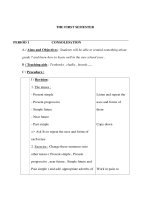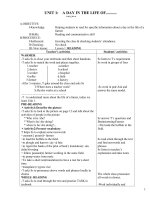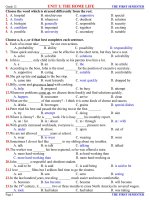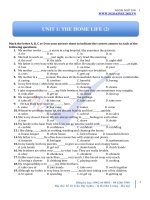UNIT 1 the natural world
Bạn đang xem bản rút gọn của tài liệu. Xem và tải ngay bản đầy đủ của tài liệu tại đây (128.3 KB, 7 trang )
UNIT 1: The Natural World
≠Environmental impacts of logging
terrestrial: thu c trên b ,
stabilize: làm n
t li n
nh
array: s p hàng, dàn hàng, s dàn tr n
intercept: ch n, ch n
ng
habitat: môi tr ng s ng
The damage includes habitat loss, pollution, and climate change, with the effects
spanning the globe from the rain forests of Central Africa...
beyond:
xa, phía bên kia
quá, v t xa h n
ngoài...ra, tr ...
The effects of logging extend beyond just the felling of a swath of trees
shelter: ch trú, che ch , b o v , n núp
Nutrients, water, and shelter for plants, animals, and microorganisms throughout the
ecosystem are also lost
integrity: tính chính tr c, tính toàn b , toàn v n
Trees protect the soil beneath then: thus, tree loss can affect soil integrity
myriad: vô s , m i nghìn
worm: trùng, sâu, giun
reptile: bò sát
amphibian: l ng c
mammal: n g v t có vú
dense: dày c , r m r p, n
canopy: vòm, tán( cây)
intact: không b n h h ng
n
The rain forest floor, home to myriad plant life as well as insects, worms, reptiles and
amphibians, and small mammals relies on a dense canopy of branches and leaves to
keep it healthy and intact
porous: x p, r
porous earth
erosion: h n hán
furrow:
ng r n c
disrupt: phá hu
compress: ép, è nén
spongy: ch hút n c, r ..
A major factor in logging-related soil damage comes from road building, with trucks
and other heavy equipment compressing the spongy soil, creating furrows where
water collects, and disrupting the underground water flow
infertile: c n c i, ko màu m
clay: t sét
layer: t ng t
Eventually, the top soil wears away, leaving behind an infertile layer of rocks and
hard clay
stream: dòng ch y
steady: u n
residue: ph n còn l i
shade: bóng
algea: t o
Vegetable along rivers and stream banks helps maintain a steady water flow by
blocking the entry of soil and other residue, and tree shade inhibits the growth of
algea
defense=defence: b o v che ch
Trees provide a natural defence against air pollution
emit: s n ra, sinh, t o ra
Trees emit oxygen, and their leaves filter pollutants from the air
deteriorate: làm h h ng, gi m giá tr
sedimentation: s ó ng c n
Water quality in nearby streams and rivers also deteriorates as tree loss contributes to
increased sedimentation
Bird migration
breed: nòi gi ng, d y d , sinh
inhabit: to live in
Migration is the regular movement of animals between their breeding grounds and the
areas that they inhabit during the rest of the year
fascinate: h p d n, cu n hút
observer: quan sát, theo dõi
Many types of animals migrate, but bird imgrationin particular has fascinated
observers for centuries
imperative(adj) c p bách, c n thi t, b t bu c, m nh l nh
(n) m nh l nh, nhu c u, i u ò i h i ph i chú ý
evolve: m ra, làm ti n hoá, lu n ra
ecological: thu c sinh thái h c
niche: ch thích h p
Migration is an excellent example of how nature has responded to the biological
imperative for species to evolve and spread out into all possible ecological niches that
can provide the conditions necessary for species to breed and raise young.
higher latitude: vùng khí hâ m áp h n
The most common form of bird migration involves traveling to higher latitudes to
breed during the warm season
optimal: t t nh t
nest: t
This form of migration allows birds to breed in areas that provide optimal conditions
for nesting and feeding their young
continent: ti t , i u , l c a
situate upon: t vào v trí
primarily: u tiên, tr c h t
Because of the way in which the continents are situated upon Earth, migration of this
type takes place primarily into the higher latitudes of the Northern Hemisphere
arctic: thu c b c c c, giá rét>
A well-know example of transequatorial migration is the arctic tern
exhibit: phô bày, tr ng bày
altitudinal: thái
Some species exhibit altitudinal migration
elevation: s nâng lên, s nâng cao
peak=top
grouse: gà gô tr ng
Their breeding areas are in higher elevations, near or at the peaks of mountains, and
they spend the nonbreeding season in neighboring valleys or other nearby low
country
unerringly: ú ng
aspect: v , b ngoài, di n m o, khía c nh
How birds manage to unerringly travel between distant locations is one aspect that
has fascinated observers for centuries.
innate: b m sinh
obscure: t i t m, m m t, t i ngh a
nocturnal: thu c v ê m
navigational: thu c v hàng h i, bi n, sông
cue: s g i ý, ra hi u
sense: giác quan
Plant life in the Taklimakan Desert
occupy: chi m gi
Sparse: th a th t
swing: u ng a , l ng l ng
The Taklimakan desert, second in size only to Africa's Sahara Desert, occupies some
337,600 square kilometers(130,300 square miles) of northwesternChina-an area about
the size of Finland.
Sparse rainfall, daily temperature swings of up to 20oC(68oF), and violent
sandstorms make it one of the most extreme evironments on Earth
shifting sand dunes: (pic)
free of: thoát kh i
Eighty-five percent of the Taklimakan Desert consists of shifting sand dunes, some up
to 250 meters tall, that are largely free of vegetation
oases: c o
(n i màu m , n i ngh thoáng mát)
fringe: ven, bìa mép
harsh: kh c nghi t
thrive: th nh v ng phát t , phát tri n nhanh
Yet, transitional areas between the open desert and oases on the desert fringe support
diverse plant forms that not only have adapted to the harsh conditions but actually
thrive there
resilient: b t n y, co giãn, à n h i, có s c b t
scorch: thiêu t , làm cháy sém
frigid: giá l nh, l nh l o
Successful desert plants are resilient to scorching summers and frigid winters,
drought, and high-salt conditions.
defense: cái b o v , s che ch , s b o v
principal: cái chính, ch y u
The plants' principal defense against these environmental stressors consist of drawing
in as much water as possible while minimizing moisture loss
prolific: sinh s n nhi u,
nhi u.
Three Taklimakan plants-Populus euphratica, Tamarix ramosissima, and
Alhagisparsifolia-represent some of the most diverse, prolific vegetation in the area;
although they share many survival strategies, each has developed unique coping
mechanisms of its own
poplar: cây b ch d ng
evaporation: s bay h i, s làm khô
stomata: l h ng, l khí
pore" l chân lông
leaf: lá cây
The Euphrates poplar, Populus euphratica, the only tall tree in the Taklimakan
ecosystem, has an extensive root system that allows it to absorb water far from the
standing tree. P.euphratica controls e vaporation by opening and closing the
stomata, or tiny pores, on the leaf surface in the surrounding air
photosynthesis: s quang h p
The stomata generally remain open during the day while the plant conducts
photos ynthesis
Like P.euphratica, tamarisk can naturally determine when to close stomata to
inhibit e vaporation and regulate photos ynthesis
endure: ch u n g, cam ch u
kéo dài, t n t i
concentrate: t p trung
P.euphratica can endure high-salt concentrations in the soil.
dilute: làm loãng
volume: kh i, th tích, dung tích
It takes in unlimited amounts of salt through the roots, up the stern, and into leaves,
where it dilutes the normally toxic salt by increasing the number and volume of its
cells
cedar: cây tuy t tùng
via: qua, theo
ng
inhibit: ng n ch n, h n ch
Tamarix ramosissima, a small tree with needlelike leaves commonly known as
tamarisk or salt cedar, takes in enormous amounts of water via a far-reaching root
system many times the size of the plant above ground
tolerance: lòng khoan dung, s tha th , s ch u
accumulate: làm giàu, ch t n g, tích...
gland: tuy n, mi ng m
saline: có mu i
ng
Tamarisk has a high tolerance for salty conditions and even produces its own salt,
which it accumulates in special glands between the leaves and then releases onto leaf
surfaces. Leaves dropping to the ground make the soil more saline, or salty, giving
tamarisk a competitive advantage over less salt-tolerant plants
spiny: có nhi u gai
shrub: cây b i
Alhagi sparsifolia, a spiny shrub, thrives in the Taklimakan Desert even though it uses
large amounts of water, especially during the summer months
With the only s few wispy roots in the upper roots in the soil, it is unaffected by
occasional flooding
ease: s thanh th n, s nhàn h ko b ràng bu c
hydraulic: ch y b ng s c n c
Unlike P.euphratica and T.ramosissima, which open and close stomata according to
conditions on the leaf surface, A.sparsifolia does so according to hydraulic
conductance-that is, the ease with which it takes up ground water
stabilize: làm cho n nh
barrier: v t ch n
conserve: gi gìn, duy trì, b o t n
Although desert plants have adapted for their own survival, they also help protect
their ecosystem by stabilizing sand dunes, preventing erosion, presenting a barrier to
sandstorms, and conserving biodiversity









